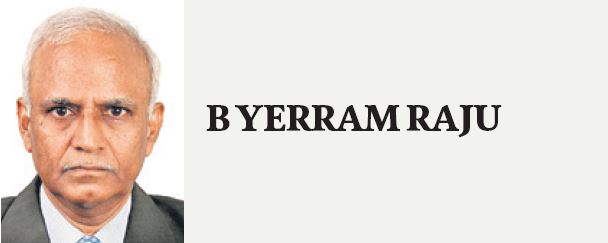Published: Published Date – 12:47 AM, Thu – 7 July 22

By B Yerram Raju
I saw the film RRR and wondered how I should title this article on Asset Quality Review (AQR) undertaken by Raghuram Rajan Reforms (RRR) in the banking sector during his regime as Governor.
The Economic Survey 2020-21 while criticising the AQR’s inability to prevent the evergreening of loans in the name of restructuring, called for dealing with it. RRR depicted the story of Komaram Bheem and India’s independence differently while one ‘R’ less, destroyed the confidence of the banks in one stroke and even a big bank like the State Bank of India had to bite the bullet in 2017.
In the context of high inflation accompanied by high growth, the credit book of banks is looking bright. The saving grace here is the fact that Indian corporates, barring a couple of large exceptions, have significantly deleveraged and are no longer so vulnerable to the debt threat. It is a moot point whether the present classification of assets into Special Mention Accounts (SMA-0,1,2) is adequate or if more regulatory and supervisory reviews are needed.
RBI’s Stance
RBI Governor Shaktikanta Das has categorically said that the central bank is neither contemplating nor feeling the necessity of taking up AQR in future. “We have really deepened our supervision. In the context of non-banking financial companies, I had said that our supervision is doing a deep dive to get a clear picture about the true state of affairs of non-performing assets. Similarly, with regard to the banks, it is part of the supervisory process. We are doing a deep dive. We are making our own assessment of the true state of NPAs in each of the banks. We are doing what an AQR needs to do. That’s happening as part of the supervision,” he said recently.
The thematic construct of AQR prevailing in Europe that RRR followed, focused on bank processes, policies, and accounting decisions. It rested on the classification of financial instruments, amortisation of financial assets in terms of cost vs fair value, equity positions, hedge accounting and derecognition. Further, it verified and validated the non-performing assets and the related provisioning, forbearance and loan restructuring methods. This was expected to lead to a reduction in information asymmetry. Banks emerging with cleaner balance sheets would be able to access capital easily from the markets and PSBs would not have to go for recapitalisation. Banks were given time till 31st March 2017.
Government View
“If the AQR had correctly identified all the hidden bad quality assets on banks’ books, all the increase in NPAs and the necessary provisioning would have concluded by the stated deadline of FY2017. However, the gross NPAs in the Indian banking sector only increased to 11.2% by FY2018. A massive surge in loan loss provisioning also occurred in FY2018 – a year after AQR was supposed to make bank balance sheets healthy,” the 2020-21 Economic Survey mentioned.
The Result
Some of the good things that happened include: bad accounts were exposed, and good money chasing bad assets also was reduced. It made banks look for structural weaknesses in the loan accounts instead of just repayment of interest as a sign of the health of the account. The scope for window dressing or evergreening accounts to favour borrowers in the name of restructuring has lessened.
The RBI and the auditors were looking at banks through a magnifying glass that disabled banks from helping genuine corporate borrowers through either excess drawings or additional overdrafts to tide over the problems caused by externalities. Top management did not encourage senior supervisory officials to help the stressed accounts with proper restructuring. This knee-jerk reaction of the RBI resulted in banks developing cold feet on welcoming fresh proposals at one end and at the other, driving away even the accounts tending to be on the margin of failure.
Risk aversion loomed so large that the micro, small, and medium enterprises (MSMEs) were bluntly denied any additional facilities consistent with their growth. Some bankers were overenthusiastic and even classified some systemic NPAs as frauds. Asset Reconstruction Companies mushroomed to buy the well-collateralised NPAs, particularly among the MSMEs. Some fraudulent transfers to the ARCs too took place, confirmed a top executive.
Sensitivities of the field staff and management hardened, stalling the one-time settlement of accounts. Staff accountability was taken to the extreme grounds of references to the Enforcement Directorate, CBI and Vigilance Commission.
Even after the RBI allowed one-time settlement of accounts to reverse the process after 2019, officials deciding on haircuts based on logical and commercial grounds were replaced with a laid down system, legal procedures and judiciary processes for recovery and stringent rules.
A top executive said: “Eyebrows raised on bankers giving a 40% haircut lowered when this went up to 90% by the National Company Law Tribunal (NCLT) judge. Bankers were happy as there was no accountability and NCLT was happy as they resolved the debt. Borrowers were happy as they got a better deal than from the bank. The public was also happy as they do not know the long-term implications.”
Frauds Continue
However, there is no evidence of a reduction in frauds as they moved from persons to the system. During the last five years, financial frauds, as per information from the RBI to an RTI query, stood at Rs 5,095 crore of which just Rs 127 crore was recovered. This is what happens if a system suited to the developed economy is applied to emerging economy, particularly, when there was no economic crisis in India.
Going by the recent increase in the credit portfolio of banks and the credit to GDP ratio expected to increase significantly, risk appetite seems to be rising. Amidst rising inflation and rate increases by several central banks, this increase would call for checks and balances in a manner that financial inclusion efforts echo positivism in the economy.
Will the RBI be able to identify corruption in banks that has spread from the bottom to the top and take spontaneous action? Will it review board-related discretions consistent with the needs of the economy and advise them to upscale or downsize where needed from the manager level to the zonal level? Will it replace the committee approach to credit decisions below certain thresholds in the interest of financial inclusion? Will it be able to ensure that manufacturing MSMEs would be restructured with the required speed by reviewing its own guidelines? Will it ensure that supply chain disruptions do not take place just for want of the required line of credit at the right time? If we were to go by what Das said, we have optimistic responses provided the focus is on improving governance and board oversight among banks.

(The writer is an Economist and Risk Management Specialist)